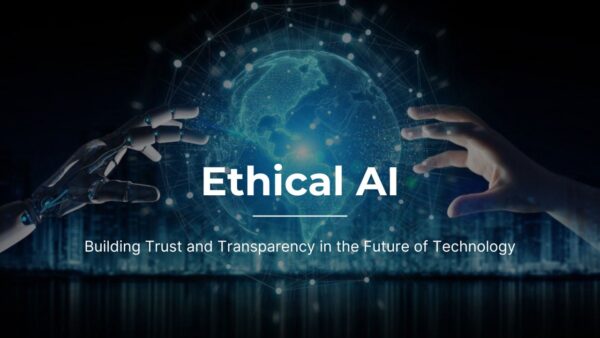Ethical AI: Guiding the Moral Compass of Artificial Intelligence
Artificial Intelligence (AI) is revolutionizing industries, enhancing our daily lives, and shaping the future of technology. However, this advancement brings with it significant ethical responsibilities. Ethical AI, which focuses on creating and deploying AI systems in a fair, transparent, and accountable manner, is essential for maintaining public trust and ensuring AI benefits everyone. This blog explores the core principles of ethical AI, the challenges involved, and the steps necessary to ethically navigate the AI landscape.
Core Principles of Ethical AI:
1. Fairness and Bias Reduction: AI systems must be designed to eliminate biases that could result in unfair treatment. This involves carefully selecting and processing training data to ensure it is unbiased and representative. Methods for detecting and mitigating bias are crucial for maintaining fairness in AI outcomes.
2. Transparency and Explainability:
3. Accountability: Accountability in AI means that developers and organizations are responsible for their AI systems’ outcomes. This includes defining clear lines of responsibility and establishing mechanisms for addressing harm or errors caused by AI. Accountability ensures that misuse or negligence is addressed appropriately.
4. Privacy and Data Security: AI systems often depend on large datasets, raising concerns about privacy and data protection. Ethical AI practices demand strong data protection measures, such as anonymization, secure storage, and strict access controls, to respect user privacy and ensure data security.
5. Human-Centric Design: Ethical AI prioritizes human well-being and aims to enhance human capabilities rather than replace them. Human-centric design focuses on creating AI systems that support human decision-making, provide valuable insights, and improve overall quality of life.
Challenges in Ethical AI Implementation:
1. Complex Ethical Dilemmas: AI systems can create complex ethical challenges, such as balancing privacy with public safety or the ethical use of AI in surveillance. Addressing these issues requires careful consideration of their societal impacts.
2. Rapid Technological Evolution: The fast-paced development of AI necessitates continuous updates to ethical guidelines. Keeping ethical standards aligned with technological advancements poses a significant challenge for regulators and organizations.
3. Global Diversity and Inclusion: AI is used worldwide, necessitating an inclusive approach that respects diverse cultural, social, and legal contexts. Ensuring AI systems accommodate this diversity is crucial for creating universally accepted ethical standards.
Steps Towards Ethical AI:
1. Developing Ethical Guidelines: Organizations and industry bodies should create comprehensive ethical guidelines for AI development and deployment. These guidelines should cover best practices for fairness, transparency, accountability, privacy, and human-centric design.
2. Fostering Cross-Disciplinary Collaboration: Ethical AI requires input from technologists, ethicists, policymakers, and other stakeholders. Collaborative teams bring diverse perspectives and expertise, ensuring thorough consideration of ethical issues.
3. Implementing Continuous Monitoring: Ongoing monitoring and evaluation of AI systems are essential for maintaining ethical standards. Regular audits, impact assessments, and updates to guidelines based on new insights and technological advances are crucial.
4. Engaging and Educating the Public: Public engagement and education about AI and its ethical implications can build trust and foster informed discussions. Transparency in AI development and decision-making processes is key to gaining public support and understanding.
Conclusion:
Ethical AI is more than just a set of guidelines; it is a commitment to creating AI systems that are fair, transparent, accountable, and aligned with human values. By addressing the challenges and adhering to the core principles of ethical AI, we can harness the power of artificial intelligence to build a better, more equitable future. Achieving ethical AI requires ongoing collaboration among technologists, policymakers, and society to navigate the moral landscape of artificial intelligence successfully.
FAQs:
1. What does Ethical AI entail?
Ethical AI refers to the principles and practices involved in designing and using artificial intelligence systems in a way that is just, transparent, accountable, and aligned with human values. Its goal is to ensure that AI technologies are developed and used in a manner that benefits society while minimizing potential risks.
2. Why is Ethical AI critical?
Ethical AI is essential because it helps prevent harmful biases, safeguards user privacy, ensures responsibility for AI decisions, and builds public confidence. By adhering to ethical standards, AI technologies can be deployed in a way that is both beneficial and respectful of societal norms.
3. How can we ensure fairness and avoid bias in AI?
To promote fairness and avoid bias in AI, it’s important to use diverse and representative datasets, apply bias detection algorithms, and regularly review and refine AI outputs. These measures help to prevent unfair treatment and promote equitable outcomes.
4. What does transparency mean in AI systems?
Transparency in AI involves making the workings of AI systems clear and understandable to users and stakeholders. This includes explaining how AI models operate and how they arrive at their conclusions, which fosters trust and allows for scrutiny.
5. How is accountability managed in AI development?
Accountability in AI is managed by defining who is responsible for the design, deployment, and outcomes of AI systems. This includes establishing protocols for addressing any issues or damages caused by AI, ensuring that developers and organizations are answerable for their AI technologies.
6. How does Ethical AI address privacy concerns?
Ethical AI addresses privacy concerns by implementing robust data protection practices, such as anonymizing personal information, securing data storage, and controlling access. These practices are designed to safeguard user data and uphold privacy rights.
7. What is the concept of human-centric design in AI?
Human-centric design in AI focuses on creating systems that complement and enhance human abilities rather than replace them. It aims to design AI solutions that support human decision-making and contribute positively to users’ lives.
8. What obstacles exist in implementing Ethical AI?
Implementing Ethical AI involves navigating complex ethical dilemmas, keeping up with rapid technological changes, and addressing diverse global perspectives. Overcoming these obstacles requires careful consideration and ongoing adjustments to practices and guidelines.
9. How can organizations create effective ethical guidelines for AI?
Organizations can develop effective ethical guidelines by forming interdisciplinary teams, consulting with ethicists, and drawing on established best practices. These guidelines should address fairness, transparency, accountability, privacy, and human-centric principles.
10. Why is interdisciplinary collaboration vital for Ethical AI?
Interdisciplinary collaboration is crucial for Ethical AI because it brings together diverse viewpoints and expertise, ensuring a comprehensive approach to ethical issues. This collaboration helps in crafting more effective and inclusive ethical standards.
11. How does ongoing monitoring enhance AI ethics?
Ongoing monitoring enhances AI ethics by providing continuous oversight of AI systems. Regular audits, impact assessments, and updates to ethical guidelines help maintain compliance with ethical standards and address any emerging issues.
12. How can public involvement improve discussions on Ethical AI?
Engaging the public through education, transparency, and open dialogue about AI and its ethical implications can build trust and promote informed decision-making. Involving the public ensures that AI technologies are aligned with societal values and expectations




